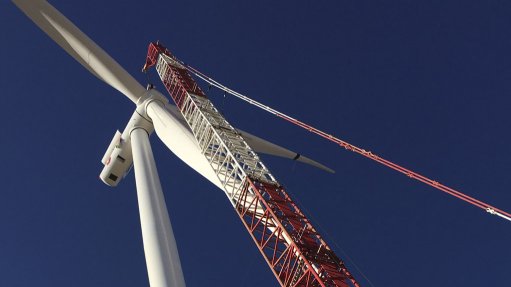
SOARING CONSTRUCTION The 100-m-tall Siemens wind turbines, which allow for optimum energy production, take between one and three days to construct, assuming favourable weather
Khobab Wind Farm, in the Northern Cape, completed all 61 wind turbine installations this month, ahead of schedule.
Further, Khobab, together with the nearby Loeriesfontein Wind Farm, in the Hantam municipality, in the Northern Cape province, has achieved more than two-million hours without a single lost-time incident during the construction period, which started in September 2015.
“This is a significant health and safety construction milestone for two of the country’s largest wind farms that collectively comprise 122 wind turbine generators and span a total of 6 653 ha,” electricity utility company Mainstream Renewable Power country construction manager Kevin Foster noted in a press release issued earlier this month.
He added that, considering the sheer scale of the project, the multiple level of activities and the complexities involved, it is an impressive achievement.
The Khobab and Loeriesfontein wind farms are owned by a consortium led by Lekela Power, a joint venture between Actis and Mainstream Renewable Power.
Other consortium members include Thebe Investment Corporation, the IDEAS Managed Fund, Futuregrowth Asset Management, Genesis Eco-Energy, in partnership with Lereko Metier Sustainable Capital, as well as the Khobab and Loeriesfontein community trusts.
The lifting of Khobab Wind Farm’s wind turbine generators was managed by a dedicated turbine installation crew, which began the lifting process during March.
The installation crew worked for days on end to take advantage of the periods of low wind to install all the turbines in under six months.
A large number of the workforce come from the Loeriesfontein community and have directly benefited from the skills development programmes.
This workforce also benefited from the experience gained on the adjacent Loeriesfontein Wind Farm, which helped the crews complete the turbine lifting ahead of schedule.
The 100-m-tall Siemens wind turbines, which allow for optimum energy production, take between one and three days to construct, assuming favourable weather.
For each turbine, three 53 m blades, made of fibreglass reinforced epoxy, are connected to the rotor before being lifted to the top of the turbine. In this lifting exercise, one crane raises the assembled rotor, while a smaller crane and taglines guide the rotor into the correct position.
The wind turbine’s tip reaches a vertical height of 154 m. The heaviest component is the nacelle, which contains the generator and gearbox, and weighs 82.5 t.
The Khobab and Loeriesfontein wind farms will have a combined capacity of 280 MW, which will be generated by their 122 wind turbines.
Loeriesfontein Wind Farm will have 61 wind turbines erected on 3 453 ha of agricultural land.
When operating at full capacity, it will generate about 563 500 MWh/y of clean renewable energy, Creamer Media Africa Research Channel reported in July.
Similarly, Khobab Wind Farm will have 61 wind turbines erected on 3 200 ha of agricultural land.
The wind farms will each connect to a 132 kV Eskom line.
When operating at full capacity, Khobab Wind Farm will generate about 563 500 MWh/y of clean renewable energy.
Khobab Wind Farm will further avoid an estimated 550 000 t/y of carbon emissions, compared with the emissions of conventional fossil fuel power plants.
The wind turbines will be supplied by Siemens Wind Power, with turbine towers manufactured at the new Gestamp wind turbine tower factory, in Atlantis, in the Western Cape.
Civil and electrical works will be completed by a consortium comprising Murray & Roberts Construction and Consolidated Power Projects.
The energy generated by the wind farms will be sold to State-owned power utility Eskom. This is in line with the 20-year power supply agreement. The wind farms were implementable as part of the third round of the Department of Energy’s Renewable Energy Independent Power Producer Procurement Programme.